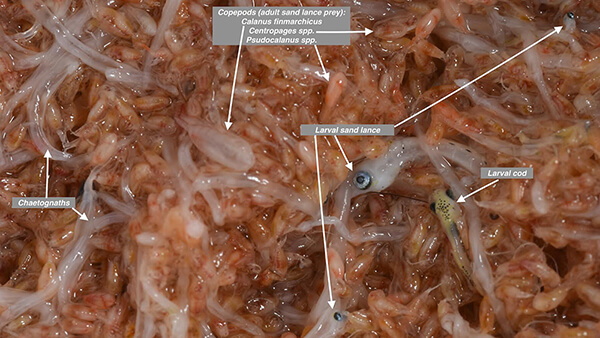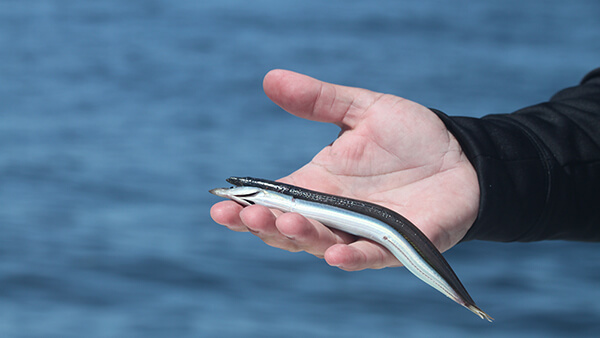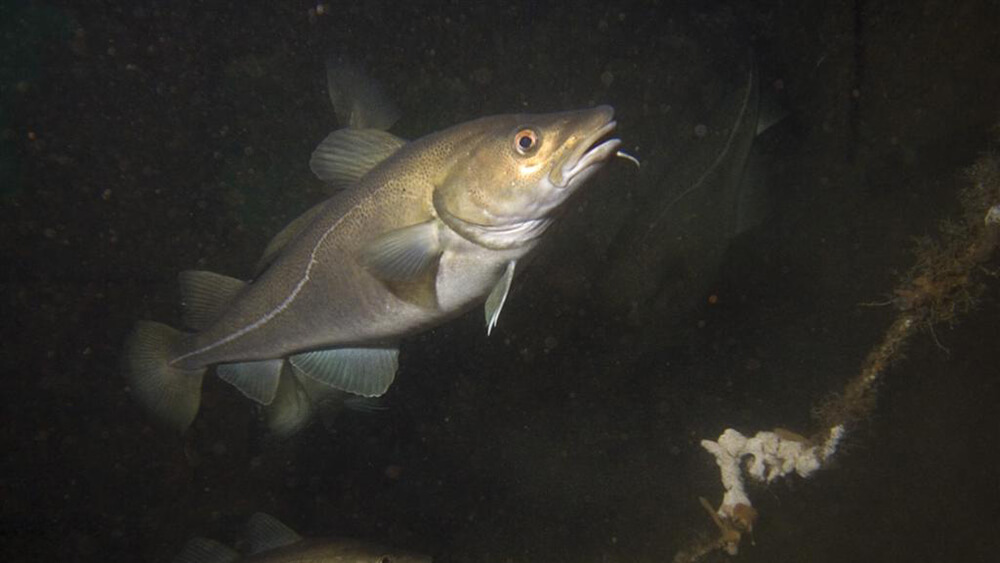Fishes
The sanctuary's "energy bar" is the small schooling sand lance. The cod is the iconic symbol of New England. These and other fishes are among the subjects studied by sanctuary scientists and their research partners.
Sand Lance Abundance, Distribution, and Life Cycle


The sanctuary's "energy bar" is the small, schooling sand lance. This species is key to the well-being of the ecosystem and the subject of a multi-year research project; partners include the U.S. Geological Survey and the University of Connecticut. Seasonal surveys at 44 stations in sandy areas around the sanctuary use video and sediment grab samples to provide information about the life cycle, abundance and distribution of this important species. These findings may provide clues to the little understood boom and bust cycle of this slippery, silvery treat.
Grunting Cod and Spawning Grounds

From 2013-2016, sanctuary scientists partnered with a multi-organization team on a project to study Atlantic cod during their winter spawning period. The project used individually tagged fish (acoustic telemetry) and autonomous underwater vehicles/gliders with listening technology to record ocean sounds, but researchers were particularly searching for male codfish producing distinctive grunts as part of their courtship rituals. The study area covered parts of Massachusetts Bay and the sanctuary. The tagged animals showed where fish were gathering, while the passive acoustic recordings from the gliders provided timing of actual spawning. The research shows a certain level of site fidelity for spawning during the November through January window, with a mid-December peak. Read the science paper.
Soniferous Fish and Passive Acoustics
The sanctuary has cooperated with various science teams studying sound-producing (soniferous) fish. One study looked at three different habitat types for fish presence; the only calls detected were by cusk in boulder habitats. The other study focused on spawning grounds for cod and haddock.
Stellwagen Bank Historical Ecology – Changes in Fish Populations
Big, top-level predators, such as halibut and swordfish, were overfished nearly to local commercial extinction in the late 19th and early 20th centuries. Researchers also found that diversity of bottom-dwelling species in the western Gulf of Maine declined from the years 1900 to 2000, as did the annual catch levels of important commercial species. Read the Marine Sanctuaries Conservation Series Report (ONMS-10-04).
Species Richness, Diversity, and Community Composition of Fishes (1970-2017)
The study looked at Time Series patterns of species richness, diversity and community composition of fishes at Stellwagen Bank National Marine Sanctuary and surrounding waters over a nearly 50-year period (1970-2017). These analyses of the larger Gulf of Maine, in which the sanctuary is nested, are used to compare regional and local scale patterns and trends. The work was used to support the 2020 Condition Report.
Atlantic Cod Site Fidelity
From 2001 to 2005, a study of Atlantic cod tested their fidelity to certain specific home areas. Using small acoustic transmitters, researchers caught, tagged, and released the fish. The animals' movements were recorded by an array of acoustic receivers deployed on the seafloor. Results showed that cod in piled boulder reefs showed a high level of site fidelity, which suggests that habitat-specific management measures may provide another avenue for conservation of this species.

